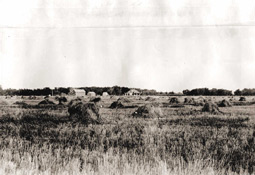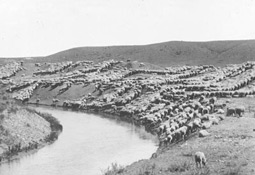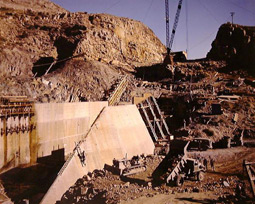- Reclamation
- Missouri Basin and Arkansas-Rio Grande-Texas Gulf
- About Us
- Regional History
Missouri Basin and Arkansas-Rio Grande-Texas Gulf Regional History:
The Bureau of Reclamation began in response to the need for stable water supplies in the semi-arid American West. Water was often not available when needed for crops, livestock, and people. At first, settlers simply diverted water from streams, but in many areas demand outstripped supply as rivers diminished following high spring flows.
Reclamation in the Missouri Basin States - The Early Years
As demand for water increased, settlers wanted to store "wasted" runoff from rains and snow for later use to make more water available in drier seasons. The stored runoff would also limit damage from flooding that occurred along rivers and streams where the most successful irrigation was practiced. Private and state-sponsored water projects were pursued but often failed because of limited financial resources or engineering skill.

Irrigation water was delivered to some farms even before the Belle Fourche project was completed. This 1915 photo shows a typical harvest scene for small grains.
It is important to remember that agriculture was the dominant industry in the West. The continued settlement of the West depended upon stable farm economies. Following the example of Native American irrigation and their own experience, the western public often strongly supported large-scale development of water projects. Congress at the time was also composed largely of farmers and others aware of the needs of agriculture. Pressure mounted for the Federal Government to undertake storage and irrigation projects.
Congress relied upon numerous reports about conditions in the West. The Lewis and Clark Expedition of 1804 sparked interest in settlement. By 1818 riverboat travel was common on the larger tributaries of the Missouri River. Federal investment followed as the Army Corps of Engineers undertook projects to improve navigation by improving river channels for safer and more reliable navigation. Even before the Homestead Act passed in 1862 organized irrigation was begun by settlers on the banks of Clear Creek in Colorado (1859). After passage of the act, free land was available for settlers that moved west in ever increasing numbers by wagon, steamboat, and the newly completed transcontinental railroad. The harsh realities of farming soon became apparent. As settlement moved further west the use of rainfall for raising crops became less reliable. Irrigation as was the answer.
In 1867 John Wesley Powell began a series of expeditions to further explore the West. He is often considered the father of reclamation because he not only detailed the land, natives, and conditions he encountered but also advocated water development and mapped locations for future dams and irrigation. Vocal supporters followed with local demands for federal involvement in irrigation projects. One such supporter was Buffalo Bill Cody (of Wild West Show fame) who realized that greater resources were required for the larger scale developments that were needed to insure stable water supplies through dry seasons. These requests increased during the 1890's when drought struck settlers prompting many to give up their dreams of hearth and home.
Congress passed the Reclamation Act of June 17, 1902. The Act required that water users repay construction costs from which they received benefits. The United States Reclamation Service began within the U.S. Geological Survey (USGS). The name Reclamation stuck because the purpose was to reclaim arid lands (by irrigation) to make them suitable for settlement. The new Reclamation Service studied potential water development projects in western states and began development using revenue from sale of Federal lands as the initial source of the funding.

Sheep graze along the main canal at Huntley Project.
From 1902 to 1907, Reclamation began about 30 projects in Western states with many of them in the Missouri River Basin. Among them was Buffalo Bill's project on the Shoshone River in Wyoming. The Belle Fourche Project in South Dakota, Huntley in Montana, North Platte in Wyoming and Nebraska, and others began in the early years of Reclamation in the Missouri Basin.
In 1907, the Secretary of the Interior separated the Reclamation Service from the USGS and created an independent bureau within the Department of the Interior. In the Bureau of Reclamation's early years, many projects continued to encounter problems because of the lack of funding, the unprecedented engineering challenges faced by builders, lack of knowledge about soils under irrigation, land speculation, and the uncertainty of repayment of project costs by irrigators.
Missouri Basin and Arkansas-Rio Grande-Texas Gulf Reclamation Evolves Multipurpose Projects
Early Reclamation works began as single-purpose projects that were designed to store and deliver irrigation water. Other benefits such as flood control, municipal water, hydropower, and fish & wildlife habitat were secondary to irrigation or were not planned during the construction of these projects. The construction of single purpose projects was assumed by the federal government. Interest-free repayment of the construction cost was considered a loan to farmers that received water and a repayment agreement was a requirement for beginning a project.
Irrigation that could be developed by diversion from streams and simple canal systems were rapidly developed by private and state sponsorship. This left the more costly and complex works for Reclamation. As irrigation development continued, the cost of facilities to store large quantities of water and deliver it through miles of canals to land distant from natural streams increased. The cost began to exceed what farmers could expect to pay when on-farm improvements necessary for irrigation were included. A part of the solution was to reconsider how the benefits of a project were computed and to redistribute repayment among them. Flood control was computed as a federal benefit since limiting damage was seen as in the national interest. Electric power generation shared in repayment by an assessment on the electricity that was passed on to customers. Others that received economic benefits from Reclamation projects, such as municipal water, also shared in repaying the cost.
By combining all the benefits larger and more costly projects were possible. Single-purpose projects serving mere thousands to tens of thousands of acres gave way to those that served hundreds of thousands of acres of irrigation along with municipal water, hydropower, and flood control for many communities. Among these are the Colorado Big Thompson (1950s) and the Fryingpan-Arkansas (1970s) projects that use miles of tunnels and a complex water collection system on the west slope of the Rocky Mountains to divert water for storage in reservoirs and use on the east slope of the mountains in Colorado. These transcontinental diversion projects are among Reclamation's most complex. Municipal water supplies, hydropower generation, flood control, and irrigation were developed to meet the needs of eastern Colorado.

Image of the construction of Boysen Dam, Wyoming taken July, 1949. This is one of the earliest color images taken in the Missouri Basin and Arkansas-Rio Grande-Texas Gulf Regions.
By the time these later projects were developed it was recognized that there were increased and often conflicting use of water that placed new demands upon Reclamation facilities. One example of how a project evolved over time is the Shoshone Project in northwest Wyoming. Originally Shoshone Dam (later renamed Buffalo Bill Dam) and a series of diversion dams and canal systems were constructed beginning in 1904 for irrigation. The available head or supply of water at a suitable pressure for hydropower was available from the dam. Water could be used to generate power as it was released from the dam for irrigation. The Shoshone Power Plant was put into service in 1922. Additional lands were irrigated and another larger power plant added in 1948. Soon after communities began to look for better municipal water supplies and the reservoir was seen as the solution. Then in 1987 the Buffalo Bill Dam modification was completed to add more power generation, increase the volume of water in storage for municipalities, improve safety and reliability of the dam, provide for more extensive recreation facilities, and to address some environmental concerns caused by the original reservoir. The modification of the project was so beneficial that the State of Wyoming shared in funding the construction. The irrigation project changed over time into a multipurpose project to meet additional demands placed upon it by a changing society but still meets the original need of providing water to irrigate some of Wyoming's most productive farms.
Missouri Basin and Arkansas-Rio Grande-Texas Gulf Regions Reclamation - Transition to Meet Contemporary Demands
Missouri Basin and Arkansas-Rio Grande-Texas Gulf Regions programs have constantly changed to meet the needs of a changing society. Facilities once created and operated solely for irrigation now need to meet other demands placed on the finite water resource. Managers recognize the need to constantly evaluate more efficient ways of working with others to solve water resource problems.
One example of a complex program that was created and has evolved to meet the needs of the west is the Pick-Sloan Missouri Basin Program. This program was created in 1944 by Congress as a compromise between the Corps of Engineers and the Bureau of Reclamation that had competing missions and plans for comprehensive water development in the Missouri River Basin. The program was a national response to severe drought and the severe flooding cycles that marked the basin. The development of facilities to tame the Missouri River and its tributaries were divided between the two federal organizations. As the Corps of Engineers developed mainstem reservoirs primarily for flood control and hydroelectric generation, Reclamation was developing features on tributaries as multipurpose projects with and emphasis on irrigation. The Pick-Sloan program gradually became increasingly complex and now encompasses a host of services not originally envisioned such as small (in population served) rural municipal water supply systems.
Similarly, the Missouri Basin and Arkansas-Rio Grande-Texas Gulf Regions organization has repeatedly adapted to meet the changing needs of the American West. Initially Reclamation projects were administered by local offices managing their construction and settlement. The 17 Reclamation states were then divided into regions for administrative support. The nine state Missouri Basin and Arkansas-Rio Grande-Texas Gulf Regions area was served by three Reclamation regions: the Southwest, Lower Missouri, and the Upper Missouri regions. The last two regions were merged in 1985 to form the Missouri Basin Region. This allowed for better planning and administration of projects (especially the Pick-Sloan Missouri Basin Program). In 1988 declining Reclamation budgets and fewer demands for construction activities led to much of the Southwest and the Missouri Basin regions merging to create the Missouri Basin and Arkansas-Rio Grande-Texas Gulf Regions. Further organizational refinements included the creation of area offices (Montana, Wyoming, Oklahoma-Texas, Nebraska-Kansas, Dakotas and Eastern Colorado) to effectively administer Reclamation Activities.

